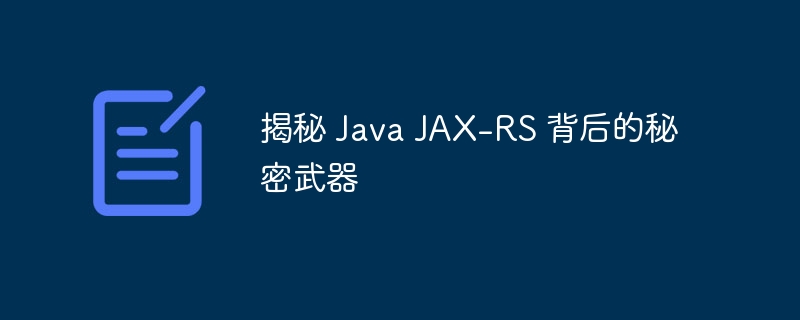

php editor Zimo takes you to reveal the secret weapon behind Java JAX-RS. Java JAX-RS is a Java API for building RESTful Web services. It provides a powerful set of tools and frameworks that allow developers to quickly and efficiently build and deploy Web services. In this article, we will delve into the core concepts, functional features and practical applications of Java JAX-RS to help you better understand and utilize this powerful technology. Let's uncover the secrets behind Java JAX-RS and explore its endless possibilities!
JAX-RS, part of the Java EE platform, provides a rich set of capabilities and features, making it an ideal choice for developing RESTful api. In addition to ease of use, high performance, and scalability, JAX-RS has the following secret sauce:
1. Annotation-driven development
JAX-RS adopts an annotation-driven development model, allowing you to use Java annotations to declare WEB resources, Http methods and parameters. This declarative approach simplifies API development, reduces boilerplate code, and improves readability and maintainability.
The following code demonstrates a RESTful service using JAX-RS annotations:
@Path("/todos")
public class TodoResource {
@GET
public List<Todo> getTodos() {
// 获取所有待办事项
}
@POST
public Todo createTodo(Todo todo) {
// 创建一个新待办事项
}
}2. RESTful service documentation
JAX-RS integrates frameworks such as swagger and OpenAPI, allowing you to use annotations to generate documentation for RESTful APIs. These documents provide developers and external systems with a detailed description of the API, including endpoints, request and response formats.
The following code demonstrates using Swagger annotations to generate documentation for a RESTful service:
@Api(value = "Todo API", description = "RESTful API for managing todos")
@Path("/todos")
public class TodoResource {
// ...
}3. Message body processing
JAX-RS supports a variety of message body handlers, allowing you to easily handle requests and responses in JSON, XML, and other formats. These handlers can automatically parse and serialize the message body, simplifying API development.
The following code demonstrates using the Jackson jsON handler to handle JSON requests:
@POST
@Consumes("application/json")
public void createTodo(@RequestBody Todo todo) {
// 使用 Jackson 解析 JSON 请求并创建 Todo 对象
}4. Client API
JAX-RS provides a client API that allows you to easily create clients for RESTful services. The client API provides all the functionality needed to interact with the server, including HTTP requests, response handling, and exception handling.
The following code demonstrates using the client API to call a RESTful service:
Client client = ClientBuilder.newClient();
WebTarget target = client.target("http://localhost:8080/todos");
Response response = target.request().get();
List<Todo> todos = response.readEntity(new GenericType<List<Todo>>() {});5. Scalability and flexibility
JAX-RS's modular design and extensible architecture allows you to customize and extend the API as needed. You can enhance the capabilities of JAX-RS by creating custom providers, interceptors, and filters to meet specific needs.
The following code demonstrates how to create a custom provider to handle custom media types:
@Provider
@Consumes("application/custom-media-type")
public class CustomMediaTypeProvider implements MessageBodyReader<CustomObject> {
// ...
}in conclusion
JAX-RS is a powerful Java library for developing RESTful web services. By leveraging its secret sauce, including annotation-driven development, RESTful service documentation, message body handling, client APIs, and extensibility, you can build efficient, maintainable, and feature-rich RESTful APIs. By embracing the power of JAX-RS, you can create seamless web experiences for your applications and users.
The above is the detailed content of Uncovering the secret weapon behind Java JAX-RS. For more information, please follow other related articles on the PHP Chinese website!




